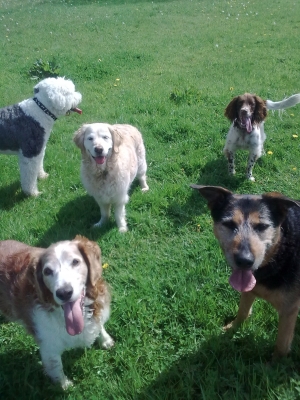'Too Many Trainers Spoil the Dog'.

When it comes to successfully training a dog or rectifying behaviour challenges, the issue of the owner quality variable is often discussed. This is the ability of the owner to follow through with the programme of retraining, to practice the advice given by the professional. What has been noted less often however, is the issue of owner quantity. Just how many people will be involved in the dog's rehabilitation & how will this affect the success rate?
Earlier this year, I started working with a family & their dog. The family had had the dog for a few years, & had struggled with possessive aggressive for some time. However, as the family grew in size-including several kids, two grandparents & numerous regular household staff-the dog's behaviour had deteriorated significantly .
By the time I was contacted, the dog had bitten practically every family member, the gardener, the childminder, house keeper, & several visiting workmen. The dog would steal items left around & then bite people when they attempted to retrieve their possessions. In all other ways, this little dog was a wonderful family pet. She had a great recall, could be handled by anyone, walked nicely on leash, was great with people in general & liked other dogs.
Following several visits & a clear, precise programme of intervention, the determined family began the task of retraining. Management was stressed as key if they were to succeed, making sure that items of value were not left around for the dog to steal. They were given strict instructions to swap stolen items for treats by tossing food to the other side of the room away from the dog. This most often resulted in her leaving the object to check out the tossed food treat. It was advised to alternate this technique with the use of distraction to divert attention away from stolen items, such as ringing the doorbell which often gets dogs to leave what they're doing & come to investigate. In addition, they should deliberately leave articles of no value around for the dog to steal. When this happened, they should approach & drop food close to the dog without speaking or touching her, thus making her less competitive & defensive about stolen articles in general.
This programme was to be implemented, in theory, by all who interacted with the dog on a day to day basis. In practice, life happens. Even a well intentioned family will have days when people don't remember the rules, or instinctively break them because they're in a rush, stressed or distracted. Asking two adult family members to understand & follow what seems like a simple set of rules is one thing. Asking their three kids, household staff & all visitors to do the same becomes almost impossible.
The reality of being a dog trainer or behaviourists is that the variables which determine our successes are often totally out of our control & can lead to failure. Success or failure is often determined by the quality of the owner & their ability to follow through with our plan. Putting it bluntly, if there are amazing dog handlers out there, there must also therefore, be some really terrible dog handlers also. Owners are after all human, with mixed ability & skill.
However, what becomes increasingly clear as you work with families & their pets is that it’s just as important to factor in the quantity variable. The more people involved in retraining of the dog, the less chance there will be for success. Even the most determined family can struggle, if the programme has a high number of participants. I read an online article last week which described a ‘simple’ way to deal with a certain dog behaviour issue. Simple is only possible in a virtual world. In the real world, rectifying dog behaviour issues is often anything but.




